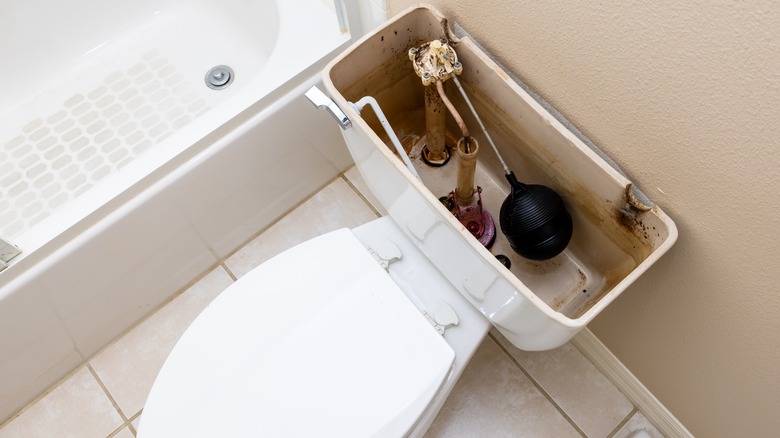Why People Are Putting Baking Soda In Their Toilet Tank (& Should You?)
Baking soda is often touted as a miracle powder when it comes to getting homes clean, keeping pests off plants and your kitchen counters, removing rust from outdoor furniture, and more. Indeed, there are seemingly endless clever uses for baking soda in the bathroom, prompting clean-obsessed homeowners to plop a handful of baking soda in their toilet tanks. It's mildly abrasive, so the idea is that it gently scrubs the tank clean, and it's also purported to deodorize a smelly tank. Should you do it? Well, the occasional dump of baking soda certainly won't harm your loo. And the ingredient's cleaning and deodorizing power is well documented.
What happens when you put baking soda in your toilet (like, the bowl) is that it removes stains and unclogs gunged-up plumbing pipes. Does it do the same for your toilet tank? The answer is mostly yes. For one, baking soda is mildly alkaline and when added to the water in, say, a toilet tank, it helps dissolve any grease, grime, and rust attached to underwater surfaces or floating around, making said dirt easier to flush or rinse away. Give everything a scrub after soaking and it'll act on messes above the waterline, too. Baking soda's alkalinity also neutralizes acids in the toilet tank. Acid slowly eats away at metals and plastics, so adding a bit of baking soda can make the parts inside work better for longer.
Fight bad smells in your toilet tank with baking soda
Toilet tanks certainly don't get as smelly as the waste-collecting bowl. But when handling so much water, algae and minerals build up. And this can leave the tank a bit smelly. Once again, it's the fact that baking soda is alkaline that helps it fight the aromas our noses reject. Most smells are caused by acids that change into a neutral — and whiff-free — compound when exposed to a base (the baking soda). In fact, baking soda is used commercially to neutralize odors in everything from overly fermented kimchi (yes, you read that right) to household organic and plastic waste and septic tanks. If it clears unpleasant scents from a septic tank, it's certain to work its magic on your regular ol' toilet tank.
In all honesty, it might be easier and more efficient to simply reach for whatever supermarket toilet cleaner you have on hand and swish that around in your toilet tank. After all, the lid on the tank keeps the interior pretty clean. But if you've run out of said product, need your toilet tank cleaned ASAP (let's say you have guests coming to stay and they'll be using your clean-routine-forgotten guest bathroom), or don't have time to run to the store, baking soda will work in a pinch. Plus, both products cost around the same price at big box retailers, but baking soda is certainly more versatile than a bottle of single-purpose toilet cleaner.
How to use baking soda in your toilet tank
Gather your supplies — at least a cup of baking soda, a long-handled brush with a bent head and sturdy bristles, and a cup measure — and don a pair of long rubber gloves. Tackle this task one of two ways: starting from a dry or water-filled tank.
For the dry method, cut the toilet's water supply and flush. It should be mostly free of water. Pour in somewhere between 1/4 and 1 cup of baking soda into the tank (advice varies, so experiment) and scrub every inch of the interior thoroughly with your brush. At this stage, you can either leave the soda-water paste to sit in the tank for 30 minutes to more than a few hours (longer won't harm the tank) and then scrub again. Turn the valve back on so the tank fills up with water, flush, and check if it's clean. If not, repeat the process. The second method is to pour the water into a tank filled with water — somewhere between 1/2 and 1 cup will do. Stir the water with your long-handled brush, leave the solution to sit for about 10 minutes, then flush.
Just note that baking soda is considered a mild smell neutralizer, so it won't work on the headiest of scents. It's also not a smell-preventative — only a treatment. You'll need to keep on top of all the ways to clean your toilet tank to prevent smells from occurring in the first place.


